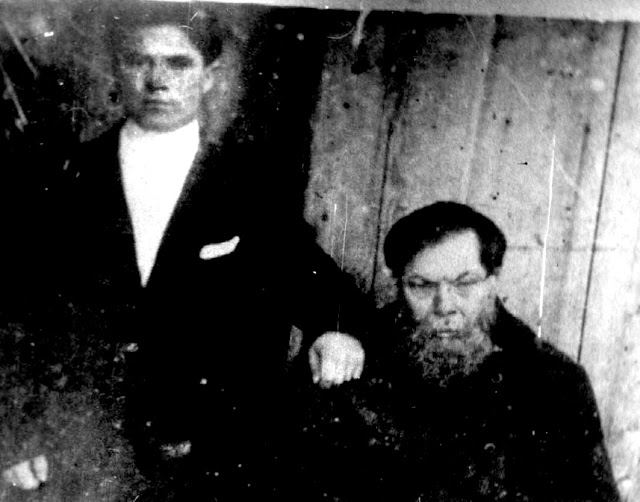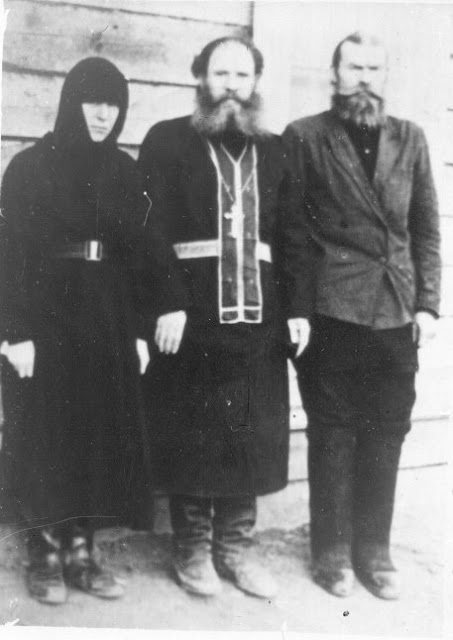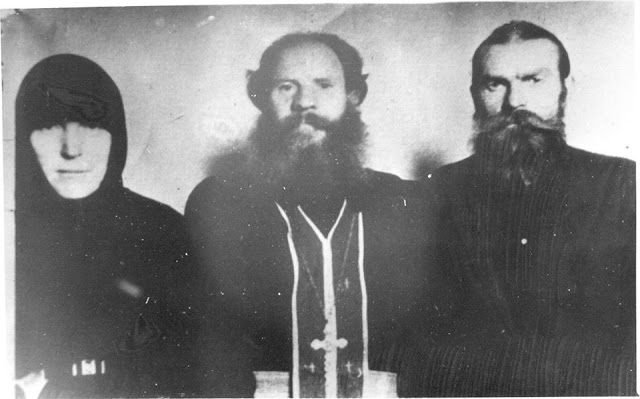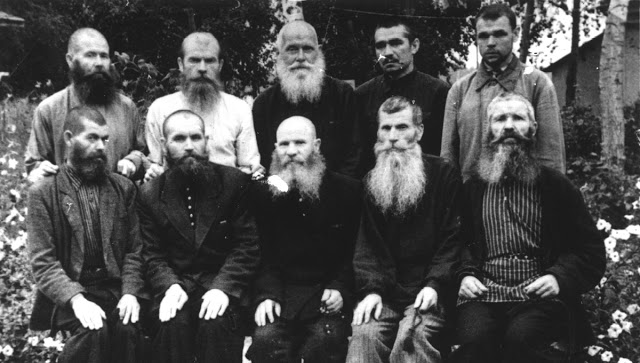The Ultimate Revelation Concerning Schema-Bishop Michael of Chistopol

A prison picture of Fr. Michael Yershov
Bishop Michael (Yershov) was born on September 17, 1911 (or October 12), in the village of Mamykovo in Kazan province, in a peasant family. His father, whose name was Basil, had taken part in the Russo-Japanese War, the First World War, and the Civil War. From 1920 he had become a cobbler and president of the committee of poverty in the village. .His mother’s name was Daria.
Michael finished two classes at elementary school, and at the age of ten began to help his father, working as a cobbler. He went to church services and sang in the choir. When he was twelve years old, as he was receiving communion in a church in Chistopol, an elder saw him and said: “This lad will take upon himself the sins of the whole people.”
From 1929 the church was closed and his father became president of the village soviet and began to persecute his son for reading service books and constantly praying at home. As a result of this, he went blind. Afterwards, when he repented, he recovered his sight.
In November 1930, Michael left his father’s home because he did not agree with the family’s joining the collective farm. At some time during that year. He arrived in Chistopol, where he fell seriously ill. On recovering, he got to know Elder Plato, who told him: “You will suffer very much for the name of God and for the people. Only don’t seek anything from anyone, rely only on Almighty God. By the mercy of God, I knew about you before.”

Michael’s spiritual father of that time, the Elder Plato was also an amazing man. Hieromonk Plato (Vasilyevich Vasilyev) was born in 1878 in the village of Pereputye, Chistopol canton into a peasant family. An invalid from birth, he was raised and lived until 1917 in the house of the merchant Chukashev in Chistopol. In the 1920s his legs were paralyzed, and he could not walk; he had to be carried and looked after by acquaintances, among whom he was known as Elder Plato. Michael and Elder Plato went together through the villages taking part in prayer services. Elder Plato had no constant domicile and had to live on alms. On March 7, 1931, he was arrested for being “a member of a counter-revolutionary monarchist organization”. On July 9 he was sentenced to death, and on July 12 he was shot.
Michael was tonsured into the mantia in 1927, and in 1928 was ordained to the diaconate. In 1930 he was ordained to the priesthood by the Catacomb Archbishop and future Hieromartyr Nectarius (Trezvinsky) in Kazan. He then wandered from place to place serving Christians of the Catacomb Church.

Fr. Michael’s first arrest was in March 1931 together with Elder Plato, for reasons of the Faith and the Orthodox Church. He was condemned to eight years in prison for anti-Soviet agitation. However, Fr. Michael was released on the 1st of May. A few days later, he was arrested again in Kazan, but was released after twelve days. He then went underground, wandering through the villages and earning his bread as a cobbler. He walked in chains, carried out prayer services, and healed the sick and the demon-possessed.
In April 1933 he was arrested in the village of Aksubayevo, but was released in July. On June 7, 1934, he was arrested in Bilyarsk, taken by convoy to Chistopol, then to Kazan and on July 10 condemned to eight years in the camps for anti-Soviet agitation. He served his term in the Mariinsk and Baikal-Amur camps, and then in Ulan-Ude and near Murmansk, doing general work.
In 1940 he was transferred to Kandalaksha, where they were building a railway. He worked in the refectory. In May 1942 he was sent to Tataria to work on the Ulyanovsk-Sviyazhsk railway. There he worked in the field hospital. On September 25 he was sent for defensive works in the village of Stepanovka, Buinsk region, from where he escaped to Chistopol, then to Aksubayevo region. On October 16 (17), 1942 he was arrested and cast into the Chistopol Prison. On January 23, 1943, he was sentenced “for desertion from defensive works” to seven (eight) years in prison. On February 16, 1943, according to one source, he was released, but according to another he was sent to call-up, but, not wishing to serve in the army, escaped. After this, he served secretly in the village of Yelantovo, Sheremetyevo region.

He celebrated Pascha on April 12, 1943, in a tent on a hill not far from Yelantovo with a group of twelve women. Later those attending the services in the tent rose to sixty. In September, during a service on the hill, the police arrived and drove away the believers; some were arrested and sent to the camps. On December 12 (or 15 or 26), 1943 he was arrested again for church preaching and cast into Chistopol prison. He was accused of being “a leader of the anti-Soviet activity of the underground of the True Orthodox Church of Tikhonite tendency in Tataria”, and on August 18, 1944, was sentenced to death by shooting. He spent 81 days in the death cell; they starved him the whole time.
On October 25, 1944, they commuted the death sentence to fifteen years’ of hard labor, of which he was informed on November 9. He was sent to Vorkutlag, where he worked in the mines, and later – in the cobblers’ workshop. In 1945 he appealed for clemency to the Presidium of the Supreme Soviet, but his request was declined.
In October 1946 he got to know Basil Kalinin, healing him from an illness of the spine which had paralyzed him completely for three years. He came up to him, took him by the hand, and said: “Get up and walk.”

Basil Kalinin 
Basil Kalinin 
Nun Nadezhda Vasilyevna (left), Vladyka Michael Yershov (center) Basil Kalinin (right) 
Nun Nadezhda Vasilyevna (left), Vladyka Michael Yershov (center) Basil Kalinin (right)
He also healed the withered hand of John Kokarev and the leprous face of Gregory Rusakov (the future Hieromonk Philaret (Rusakov) ), which was already rotting.
Fr. Michael passed through almost all the prisons of the Soviet Gulag: Kazan, Arzamas, Vorkuta, Olga, Bannino, Sakhalin, Nagayeva, Magadan, Suman, Kolyma, Khabarovsk, Blagoveshchensk, Bratsk, Taipet.

It is said that in the 1950s Fr. Michael was secretly consecrated Bishop of Chistopol* in the camps, and in this capacity took part, according to one source, in the Nikolsky Council of the Catacomb Church in 1961 through Monk John. However, the real existence of this Council is doubted by many.
*There are varying beliefs about whether Fr. Michael was made a bishop in the camps. Thus according to an article of Alexei Kiselev, based on an interview with Anatoly Levitin (Krasnov), when Osipov was in a concentration camp in the 1960’s “he met a strange old man whom all the prisoners called ‘Vladyka.’ This was Michael, a bishop of the True-Orthodox Church. He made a powerful impression on Osipov and this encounter, it may be, is what turned him to religion.” However according to Eugene Vagin, “Hieromonk Michael Vasielich Yershov, whom many also called ‘Vladyka,’ was not a bishop”.

On August 3, 1950, he was transferred to Sevvostoklag (Kolyma, North-East Siberia), where he worked in the gold-fields. On November 15, 1954, he was recorded in his personal file as having worked only 54 days, while there was a series of decrees casting him into the isolator for between three and ten days for refusing to work. On July 14, 1954, his sentence was reduced by one-third.
In December 1954 he was transferred from Kolyma to the camp section Sovietskaya Gavan, Khabarovsk district. On May 29, 1956, he was transferred to a prison regime for one year and was sent to prison in Blagoveschensk. On July 4, 1958, the following report was written about him: “During his stay in prison, he behaved satisfactorily, and did not violate the prison regime, was a cleaner in the corridors of the prison and carried out his work. A religious fanatic, he did not work on days that were, in his opinion, festal.”
On April 11, he was transferred to the inner prison of the KGB in Kazan for investigation in connection with a church case. On July 18 he was indicted for being “the leader of the anti-Soviet underground of the True Orthodox Church in Tataria. By means of written and personal links with those who think like him, he gave instructions on preaching the ideas of the True Orthodox Church, called on people to refuse to participate in political enterprises and decline from service in the Soviet Army, in collective farms, in state institutions and undertakings. He gave instructions on preparing new secret priests, and on acquiring houses and equipment for an illegal church.”
On August 11-14, 1958 he was sentenced to twenty-five years in the camps with five years of disenfranchisement, and was sent to Dubravlag, Potma, Mordovia. “At eight in the morning, they brought Vladyka Michael (Yershov)in a ‘black raven’. He raised his hand like this, crossed himself, and bowed to the earth. ‘Pray and fear not. The victory will be with the True Orthodox Christians!’. Then they took him away.
After him, they brought in Basil Vladimirovich, and he also said: ‘All of you pray for us, pray. The spirit is willing, but the flesh is weak.’ Then they brought in Fr. Philaret, and after him Ivan, and the last was Nadezhda Vasilyevna (see her life below). They brought them through, and they all shouted: ‘Pray! The victory will be with the True Orthodox Christians!’. They gave them twenty-five years of strict regime’.”

Vladyka Michael spent fifteen years in irons. According to the accounts of prisoners, he spent whole nights standing in prayer. He healed many criminals, possessed, lame, blind, and sick people, and gave them instructions on how to live well. He also had the gift of prophecy.
On August 13, 1973, he declared a hunger strike in the camp. In October he was transferred to the seventeenth section of the Temnikov camp (Potma). In the spring of 1974, they pulled out all his hair and all the hairs of his beard one by one with manacles, after which he was paralyzed.

A.S. Dubina reported that Bishop Michael died in camp on June 4, 1977. According to another report, however, he died in a special prison hospital on June 4, 1974.
However, his relatives heard that he had been transferred to the Kazan special psychiatric hospital. It seems that the secret was let out by the procurator of the town of Kazan when he was receiving his relatives. It is possible that the authorities wanted to hide him from the believing people because of his great popularity – he was known as “the Tsar of Mordovia” and people came to catch a glimpse of him through the barbed wire from all over the Soviet Union. Bishop Michael himself prophesied that they were going to hide him, and he ordered them not to believe the story of his death. All his spiritual children were convinced that he had been hidden away in a psychiatric hospital so as to be annihilated there.

Bishop Michael was a fervent opponent of the Sergianist church organization (which after 1943 began to be called the Moscow Patriarchate). According to Eugene Vagin, he believed that it was wrong to have any contact whatsoever with Moscow Patriarchal churches.
(Sources: Les Cahiers du Samizdat, April 1978; Russkoye Vozrozhdeniye, 1978, N 4, pp. 39-42; Schema-Monk Epiphanius (Chernov), Tserkov’ Katakombnaya na Zemlye Rossijskoj (MS), 1980; I.M. Andreyev, Russia’s Catacomb Saints, Platina: St. Herman Monastery Press, 1982, chapter 42; Chronicle of Current Events, no. 32, p. 80; Bishop Ambrose (von Sievers), “Episkopat Istinno-Pravoslavnoj Katakombnoj Tserkvi”, Russkoye Pravoslaviye, N 4 (8), 1997, pp. 14-15; “Katakombnaya Tserkov’: Tainij Sobor 1948g.”, Russkoye Pravoslaviye, N 5 (9), 1997, pp. 20, 27; I.I. Osipova, Skvoz’ Ogn’ Muchenij i Vody Slyoz”, Moscow: Serebryanniye Niti, 1998, pp. 180-182, 259) catacombhistory.blogspot.com)








Saint Martyr Michael of Chistopol, prayer the God for us!